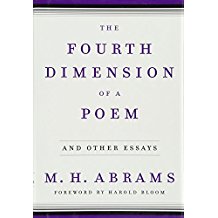The Fourth Dimension of a Poem, M.H. Abrams, 2012
A most delightful and thought-provoking book by a literary critic who has been the teacher of Bloom and Greenblatt and who, at 101, is still writing and thinking. The eponymous essay adds to the usual 3 dimensions of a poem—the structure on the page, the sounds of the words, and the meaning—a new element, the utterance. Abrams argues that the great poet, specifically Keats’ ‘To Autumn’ in the second essay, writes with a view to how the poem’s syllables and words are formed with the mouth and palate and how that utterance adds to the other elements to achieve the full expression of the poem. He illustrates his point with 6 wonderful poems by Auden, Dickenson, Wordsworth, Tennyson, Dowson (Cynara), and Ammons whose creative dimension of language enriches their work. He refers to Frost’s description of each poet’s distinctive ‘sounds, that they make rise to one from the page.’ Other essays delve into literary criticism, analyzing structuralism and humanistic criticism, the former focused entirely on the text while the latter encompasses the author, the environs, the reader and the text. The latter creates a narrative sequence within which the reader and writer recognize that they face choices and consequences in a natural world and that as thinking, feeling individuals their choices can be judged. These intellectual and imaginative products express an individual’s form of life—-vision, assumptions, and values. Additional essays discuss the Romantic poets and their view of nature, discuss two divergent views of a Wordsworth poem, Kant’s view of art for art’s sake, and Hazlitt’s essays. A wonderful book to read and to return to for exploration of art and what a classic is. His view of a classic is summarized as follows: “Agreement among diverse humanists as to the importance and value of a work at any one time, and still more, the survival value of a work—general agreement as to its importance and value over an extended period of time—serves as a sound way to distinguish the better from the worse and to identity which work is a classic. The consensus that emerges when an imaginative work is viewed from a diversity of critical perspective and through a diversity of sensibilities—and especially a consensus that emerges despite radical cultural changes over many centuries—is a reliable index to the fact that the work is central in its human concerns, broad in its imaginative appeal, and rich in its inherent aesthetic and other values.”



